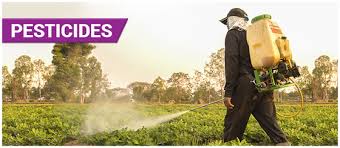
Pesticides
PESTICIDES
Any living organism that hinders the growth of crops is a pest and a man-made chemical used to kill a pest is called a pesticide. Target pests can include insects, plant pathogens, weeds, mollusks, birds, mammals, fish, nematodes (roundworms), and microbes that destroy property, cause nuisance, spread disease or are vectors for disease. Although there are benefits to the use of pesticides, some also have drawbacks, such as potential toxicity to humans and other animals. Pesticides can be specific in their action. When they are used to kill insects, they are called insecticides; likewise a fungicide is used to eliminate unwanted fungi. The most common use of pesticides is as plant protection products (also known as crop protection products), which in general protect plants from damaging influences such as weeds, diseases or insects. This use of pesticides is so common that the term pesticide is often treated as synonymous with plant protection product, although it is in fact a broader term, as pesticides are also used for non-agricultural purposes.
For many years, DDT (dichlorodiphenyltrichloroethane) was used to kill pests. It kills by destroying the nervous tissue of insects. DDT tends to remain active for a long time. It accumulates in animal tissues as it moves up the food chain. It can also enter our body. Therefore, its use is not advisable. Arsenic compounds of lead and calcium are often used in fruit sprays. Since these compounds as well as many other insecticides are poisonous, it is important that all vegetables and fruits always be thoroughly washed before they are eaten.
Problems of use of Pesticides;
The three major problems which limit the continued usefulness of pesticides are:
- Some pest organisms have developed resistance to chemicals.
- Some pesticides are not readily biodegradable and tend to persist for years in the environment (in water and soil both). These chemicals move to other parts of the environment.
- The detrimental effects of chemicals on organisms other than the target pests. Soil flora and fauna may be adversely affected. Birds and fish tend to consume these chemicals in their body tissue in some cases to toxic levels.
Classification of Pesticides;
Pesticides can be classified into following groups:
(a) Insecticides used to kill insects:
Chlorinated hydrocarbons: BHC, Ethylene dichloride, Toxaphene, Endrin, DDT, Aldrin, Dialdrin
Organophosphates: Diazinon, Parathion, Melathion, Dimethoate, Manazon, Systox.
Carbamates: Sevin
(b) Fungicides are chemicals used to kill fungi, bacteria and viruses.
Mercurials: Ceresan
Dithiocarbamates: Ferbam, Ziram, Maneb, Thiram
Others: S, SO2, Copper Sulphate, Copper Oxychloride, Copper Zinc Chromates, Cuprous Oxide, Basic Copper Sulphate
(c) Herbicides are used to kill weeds without harming the crop.
Aliphatic acids: Trichloroacetic acid, 2, 2, 2-dichloropropionic acid
Phenylureas: Monuron, Diuron, Fenuron, Linuron
Carbamates: Isopropyl carbanilate, isopropyl m-chlorocarbanilate
Dinitroanilines: Dipropalin, Benefin, Trifluralin
Bipyridyliums: Paraquat, Diquat
(d) Fumigants are highly volatile, small moleculed fungicides that have fumigant action e.g., Methyl bromide, trichloronitromethane, methyl isothiocyanate.
(e) Antibiotics fungicides are substances produced by micro-organisms which destroy other micro-organisms such as penicillin, tetracyline and chloramphenicol.
(f) Rodenticides are the chemicals which damage small mammals especially rodents like rats, mice etc., which damage man’s dwellings, his stored products, and his culivated crops like-Phosphorus, coumarins, organochlorines etc.
(g) Nematicides are the chemicals which kill or harm nematodes (round worms that live in soil or water) such as halogenated hydrocarbons, organophosphates, isothocyanates.
The insecticides can be divided into four groups based on their mode of action:
(i) Protoplasmic poisons: Chemicals like lead arsenate, sodium arsenite etc. kill all types of cells by poisoning them and by precipitating protein.
(ii) Respiratory poisons: The fumigants like hydrocyanic acid gas, ethylene dibromide, methyl bromide and ethylene dichloride kill the insects by inactivating the respiratory enzymes (oxidases, peroxidases, reductases etc.).
(iii) Physical poisons: These poisons kill by some physical action such as excluding air, for example, silica dusts and charcoal dust.
(iv) Nerve poisons: DDT, malathion, parathion etc. may be classed together as nerve poisons. DDT initiates high nervous excitation and causes the release of excessive amounts of neuroactive substance. When it is produced in large amounts, it becomes toxicant and disrupts normal nerve functions.
Melathion causes tremours, convulsion, muscle paralysis and finally death.


